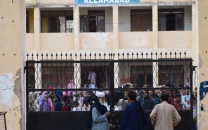Floods aftermath: Real challenges lie ahead
Three months after the floods, 7 million remain without adequate shelter.

Floods aftermath: Real challenges lie ahead
According to the National Disaster Management Authority (NDMA), more than 1.7 million houses were destroyed or damaged by the floods, which started at the end of July in the north of the county before rolling south in an unprecedented wave of destruction.
The 70 agencies of the International Organisation of Migration (IOM)-led Shelter Cluster have delivered emergency shelter to 543,131 families or around 3.8 million people so far. But an estimated 7 million people have yet to be reached.
“The immense scale of the disaster continues to pose a huge challenge to the government and aid agencies. We are still a long way from providing shelter to every flood victim,” says IOM Regional Representative for West & Central Asia Hassan Abdel Moneim Mostafa.
Unmet shelter needs are particularly high in Sindh province, where the flood waters have only recently receded. In some areas, such as Dadu district, some people are still trapped by stagnant pools that have yet to drain away.
According to the government, nearly one million homes were damaged or destroyed in the province. IOM has been scaling up the distribution of shelter and other essential aid items through its provincial hubs in Sukkur and Hyderabad, but the needs still far outstrip the capacity of the government and aid agencies on the ground to deliver.
In Punjab, where around half a million homes were destroyed or damaged, most people have returned to their places of origin. IOM and its cluster partners have provided thousands of families with non-food relief items, including tarpaulins, blankets, kitchen sets and jerry cans. At the same time, IOM has launched a pilot early recovery programme in Sindh and Punjab, helping those flood victims who are able to return to their land to rebuild their homes.
The scheme aims to provide families with one-room shelters using locally procured materials and traditional construction methods.
“The project is designed to meet the different needs of each family and to encourage community self-help. IOM will provide essential materials and technical advice, but families will have to build their own shelters, with the help of their neighbours,” says Abdel Moneim Mostafa.
As the waters recede and people return home, IOM has also ramped up its activities in the field of mass communications and health. Its mass communications program informs flood victims about the availability of relief services and how to access them, and helps aid agencies to disseminate crucial humanitarian information.
In the field of health, IOM has also set up four clinics in Punjab and Sindh that have treated over 10,000 patients since they opened in September. Most people were treated for acute respiratory infections, gastroenteritis and suspected malaria.
“Overall, we’re much better off now than right after the floods when we had diarrhoea and other diseases and spent eight days on the roof of our house without enough food. But we still lack medicines,” says Sadiq Hussain, a 48-year-old father of 12.
IOM’s Pakistan Emergency Flood Response has appealed for US$114 million and to date has confirmed funding of US$33.7 million from international donors. These include the UK, the USA, Canada, Japan, Sweden, ECHO, the UN Central Emergency Response Fund, and the multi-donor Pakistan Emergency Relief Fund.
Published in The Express Tribune, November 3rd, 2010.



















COMMENTS
Comments are moderated and generally will be posted if they are on-topic and not abusive.
For more information, please see our Comments FAQ